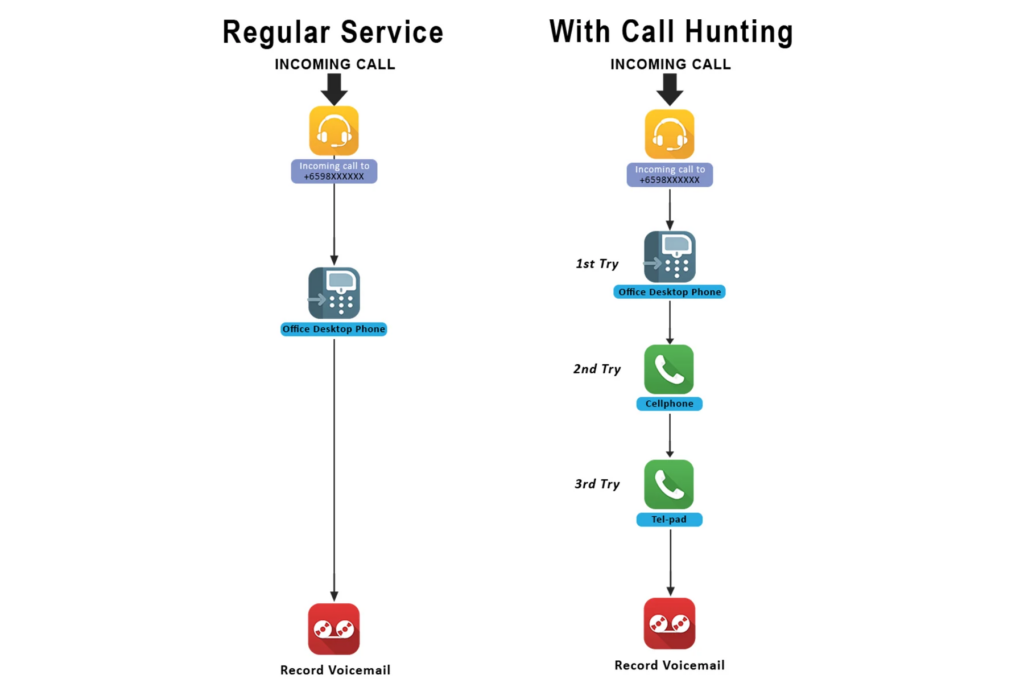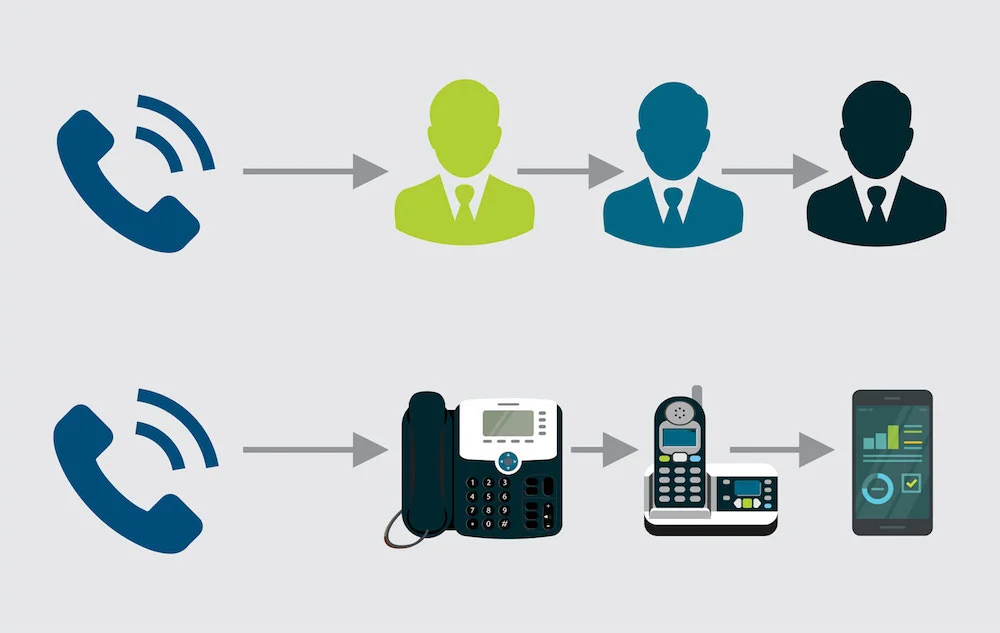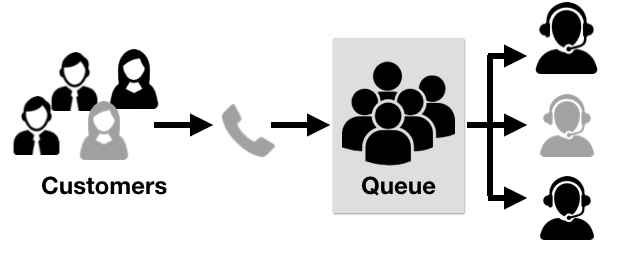Call hunting is an essential phone system feature that routes incoming calls to available agents efficiently when the originally dialed number is busy or unavailable.
It prevents calls from going to voicemail and improves response times.
This article will explain what call hunting is, compare it to similar features like call forwarding and call routing, discuss find me/follow me vs ACD, outline who benefits from find me/follow me, describe the different types of call hunting, and answer common frequently asked questions.
Read on to gain a comprehensive understanding of this important phone system capability.

Key Aspects of Call Hunting
- Hunt Group: The group of numbers designated to receive forwarded calls in a defined order when the main number is unavailable.
- Hunt Sequence: The order in which the call gets redirected to the numbers in the hunt group. This sequence can be linear, circular, or in a custom-defined priority order.
- Busy Mode: Determines if the call gets forwarded when the main number is already in a call.
- No Answer Mode: Determines the rings-no-answer threshold after which the call gets forwarded.
- Simultaneous Mode: Determines if the call rings multiple numbers at the same time until answered.

Call Hunting vs. Call Forwarding vs. Call Routing
Call Hunting:
- Hunt groups allow incoming calls to be distributed or “hunted” across a group of agents.
- If the first agent is busy, the call goes to the next available agent in the group.
- Improves customer experience by reducing wait times.
- Requires intelligent call distribution to route calls effectively.
Call Forwarding:
- Forward incoming calls to a different phone number if the initial number is busy or not answered.
- Can forward to a mobile phone, alternate office number, etc.
- Simple to set up but limited flexibility.
- Agent has control over where calls are forwarded.
Call Routing:
- Uses advanced call routing rules to send calls to the optimal agent or destination.
- Considers factors like agent skills, availability, time of day, and more.
- Provides the most efficient call handling and distribution.
- Requires more complex configuration but enables greater flexibility.
Types of Call Hunting
1. Linear Hunting
Linear hunting, also known as serial hunting, is the most basic type of call hunting.
With linear hunting, calls are sent to agents sequentially, starting from the first agent on the list.
If the first agent doesn’t answer, the call rolls over to the next agent, and so on down the list until an agent answers.

How It Works
- Calls are distributed to agents in a set order.
- If an agent doesn’t answer, the call moves to the next agent on the list.
- Once an agent answers a call, they are moved to the bottom of the list.
Pros
- Simple to set up and manage.
- Agents can focus on their current calls without being interrupted by additional calls.
Cons
- Agents at the top of the list receive more calls than those at the bottom.
- Long wait times if multiple agents don’t answer.
2. Circular Hunting
With circular hunting, incoming calls are sent to the agent who has been idle the longest rather than sequentially.
How it Works
- The system tracks which agents have been idle the longest.
- Incoming calls are routed to the agent who has been idle the most.
- Once an agent takes a call, they drop to the bottom of the idle list.
Pros
- Ensures a relatively even distribution of calls across all agents.
- Shorter wait times compared to linear hunting.
Cons
- More complex to set up and manage than linear hunting.
- Agents who wrap up calls quickly get more calls.

3. Uniform Call Distribution
Uniform call distribution aims to distribute incoming calls evenly across all available agents.
How It Works
- Uses an algorithm to evaluate all agents’ availability.
- Routes calls to the agent that has been idle the percentage closest to the optimal idle percentage.
Pros
- Excellent load balancing across agents.
- Most equitable call distribution.
Cons
- Requires more sophisticated call routing software.
- Difficult to implement effectively.

4. Priority Routing
With priority routing, incoming calls are sent to agents based on assigned priority levels.
How It Works
- Agents are assigned priority levels, such as P1, P2, P3.
- Incoming calls attempt to route to highest priority agent first.
- If unavailable, rolls over to next priority level agent.
Pros
- Ensures high-value clients reach highest skilled agents.
- Customizable for different priorities.
Cons
- More complex to manage priorities.
- Lower priority customers experience longer waits.

5. Skills-Based Routing
Skills-based routing directs calls to agents based on the skills required for that call.
How It Works
- Agents self-identify with skills/expertise.
- Incoming calls are matched to agents with designated skills.
Pros
- Customers reach agents best qualified to handle query.
- Agents only get calls matching their expertise.
Cons
- More complex to set up skills and routing rules.
- Imbalanced distribution if skills mismatch call volume.

Find Me/Follow Me vs. ACD
Find Me/Follow Me:
- Enables calls to “find” an individual subscriber by ringing multiple devices.
- Follows the user by routing calls to different numbers throughout the day.
- Beneficial for mobile and remote workers.
- Focuses on connecting callers with a specific person.
ACD (Automatic Call Distribution):
- Distributes high call volumes across a group of agents.
- Queues calls and connects them intelligently.
- Maximizes agent productivity and minimizes wait times.
- Reporting provides insights into call volumes, times, etc.
- Focuses on efficiently routing calls to any available agent.
Who Benefits From Find Me/Follow Me?
Find me/follow me improves answer rates by call redirection and benefits:
- Small businesses – Redirects calls dynamically between team members’ phones/mobiles when the original called number is occupied. Prevents missing customer calls.
- Professionals and executives – Forwards unanswered calls from their office number to their mobile when they are out of the office or in a meeting. Ensures no calls are missed.
- Sales teams – Calls reaching an unavailable salesperson get directed sequentially to other available team members so that no sales call is lost.
- Support teams – Calls get answered by any next available support rep if the primary recipient is busy. Prevents long wait times and improves response rates.
- Front desk/operators – Calls get redirected dynamically to alternate desk phones ensuring someone answers promptly with a professional front desk-like experience.
Frequently Asked Questions (FAQ)
Ques 1. What happens if no one from the hunt group picks up the forwarded call?
Ans. The call continues hunting through the entire hunt sequence.
Once all alternate numbers have rung without an answer, the call finally reaches voicemail or queues up awaiting agent availability in case of a call center.
The caller also has the option to hang up earlier if they don’t wish to wait.
Ques 2. Does the hunted call display the originally dialed number or an alternate forwarded number?
Ans. The caller continues to see the originally dialed phone number only.
The internal forwarding happens in the background with no visible change from the caller’s perspective.
Ques 3. Can a single user be a part of multiple hunt groups?
Ans. Yes, there are no limitations on including a user in multiple hunt groups.
A user’s phone can ring for incoming calls to each hunt group they are a member of.
Ques 4. Does call hunting work across mixed phone environments?
Ans. Call hunting is flexible and technology-agnostic.
Hunting can work across different phone systems, with redirecting between landlines, VoIP lines, softphones, and even mobile phones.
Ques 5. Can the hunt sequence be changed easily if team members join/leave?
Ans. The hunt sequence and group are configurable through a control panel or phone system admin interface.
It can be modified in real-time by adding/removing members or changing order as needed when team composition changes.






